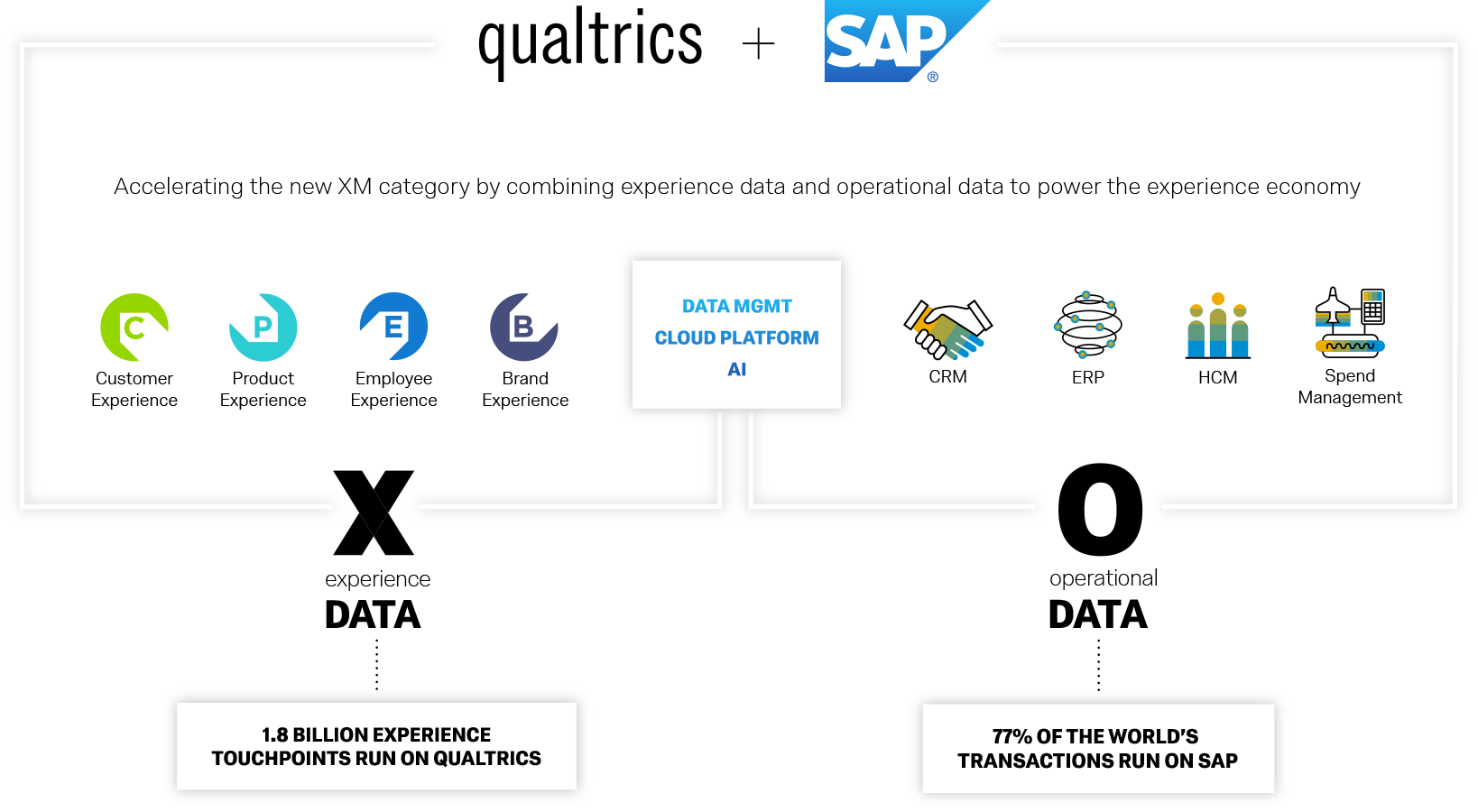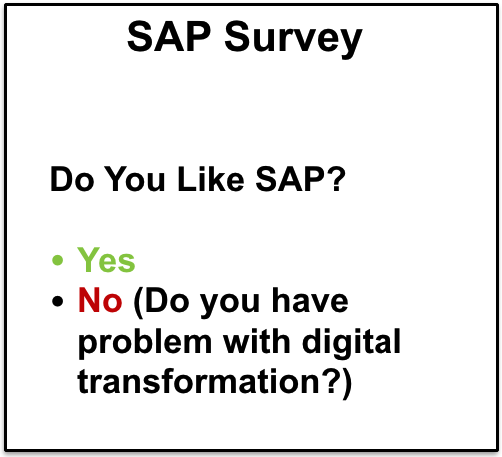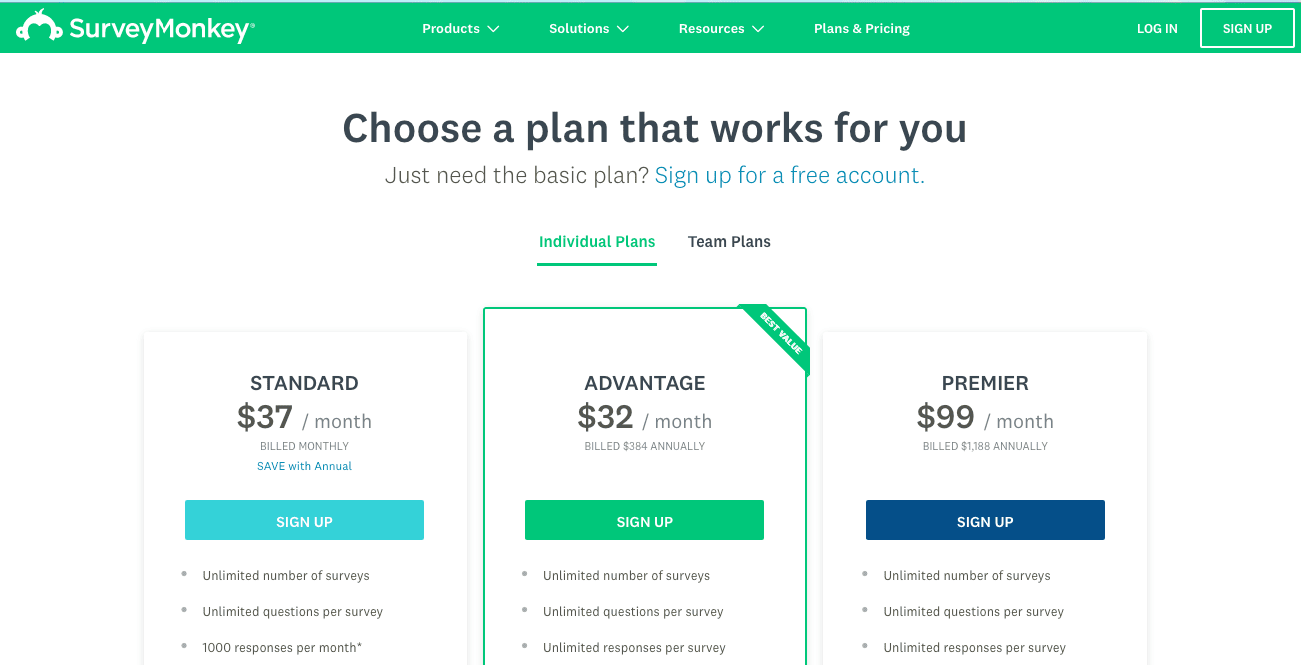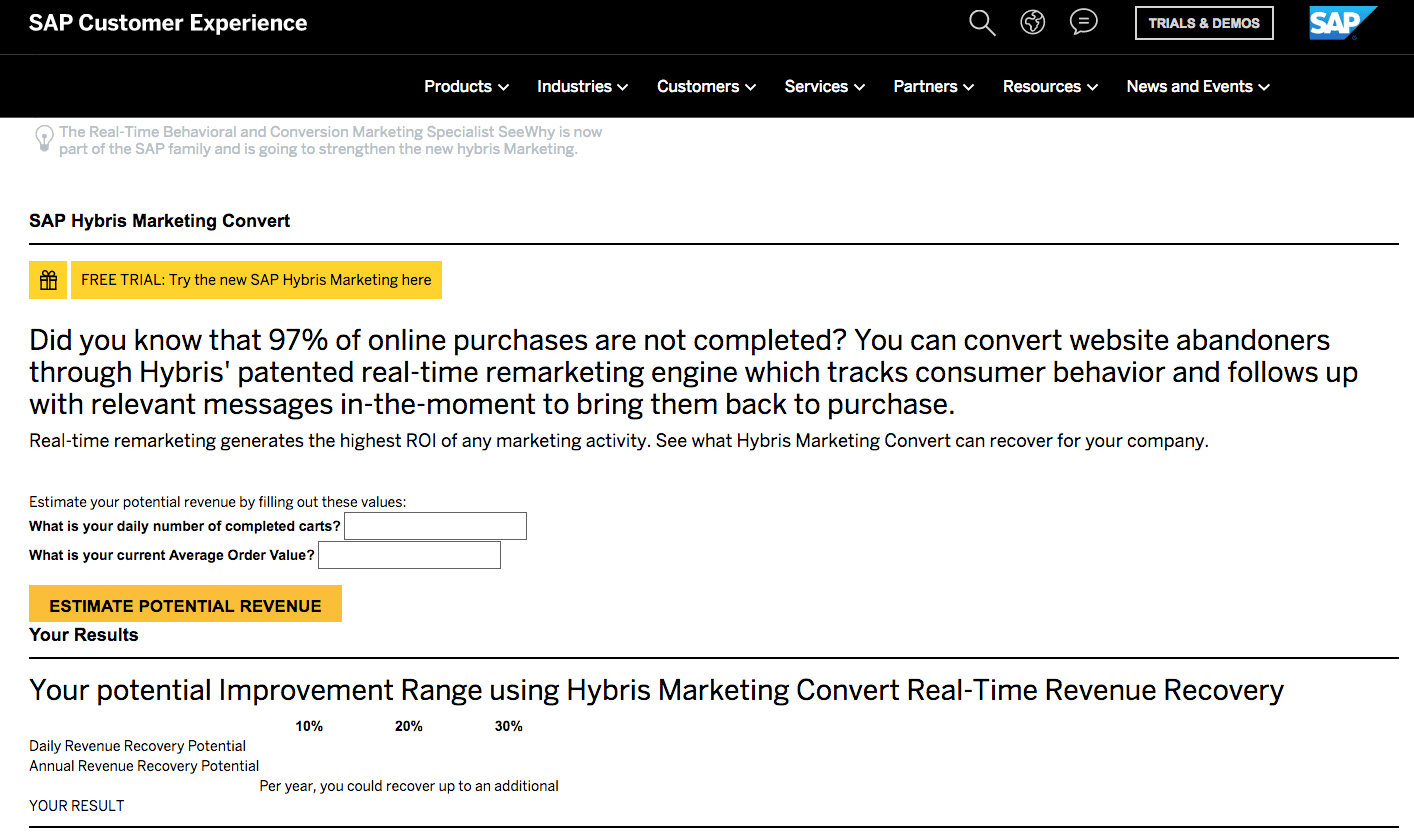Does SAP’s Acquisition of Qualtrics Make Any Sense?
Executive Summary
- SAP acquired the vendor called Qualtrics, a vendor that most people in SAP have never heard of.
- Learn the likelihood that Qualtrics will be a successful acquisition for SAP.

Video Introduction: Does SAP’s Acquisition of Qualtrics Make Any Sense?
Text Introduction (Skip if You Watched the Video)
Is survey software critical to SAP’s future? With the acquisition of Qualrics, SAP says it is. However what is known about Qualtrics? We found out some concerning details by reading Glass Door reviews on Qualtrics. There is also the question of why SAP would make such bizarre acquisitions at such a high price. In order to sell the acquisition, SAP has made some very enlarged claims about how Qualtrics will fit into SAP’s other offerings. You will see our analysis of how accurate SAP’s claims regarding this acquisition.
Our References for This Article
If you want to see our references for this article and other related Brightwork articles, see this link.
Notice of Lack of Financial Bias: We have no financial ties to SAP or any other entity mentioned in this article.
- This is published by a research entity, not some lowbrow entity that is part of the SAP ecosystem.
- Second, no one paid for this article to be written, and it is not pretending to inform you while being rigged to sell you software or consulting services. Unlike nearly every other article you will find from Google on this topic, it has had no input from any company's marketing or sales department. As you are reading this article, consider how rare this is. The vast majority of information on the Internet on SAP is provided by SAP, which is filled with false claims and sleazy consulting companies and SAP consultants who will tell any lie for personal benefit. Furthermore, SAP pays off all IT analysts -- who have the same concern for accuracy as SAP. Not one of these entities will disclose their pro-SAP financial bias to their readers.
The Need for Acquiring a Survey and Survey Analytics Firm?
SAP has one product that they use to open accounts and to sell other applications. This is their ERP system (currently ECC, the new version being S/4HANA). Every acquisition SAP makes needs to be interpreted by how its sales can be enhanced through association with SAP ERP. Both Qualtrics CEO Ryan Smith and Billy McDermott stated that:
“Qualtrics has completely transformed the experience management category.”
That seems like an odd statement. What is that category?
Here is the pitch.

SAP seems to think this is a logical breakdown of how data works or should be viewed.
“Operational Data (O-Data™) tells you what is happening. Experience Data (X-Data™) tells you why.”
Bill McDermott addressed this concept as a distinct separation between X and O data in the following quote.
“In that context, he saw the deal as transformative. “By combining this experience data with operations, we can combine this through Qualtrics and SAP in a way that the world has never done before, and I fundamentally believe it will change this world as we know it today,” McDermott told TechCrunch on Monday.”
The problem with this construct is that SAP has very few forward facing applications. SAP primarily makes internal enterprise software. Surveys can be added to these, but companies usually don’t care what their employees want, so there is little overlap with what SAP has to offer. This makes the acquisition a problematic fit, particularly given the valuation.
SAP Cares What Users Think?
I have been telling companies for years that SAP’s solutions leave their employees less able to do their jobs, but the response that I usually get is that “the decision has been made” to go in XYZ direction with SAP. So as far as I can ascertain, companies typically don’t care about employee satisfaction or feedback on the software they acquired. SAP plays into this by force-feeding media entities to write complimentary things about their software and by “going over the heads” of the users and selling to the “C-suite.” SAP’s overall strategy is to disregard the input from users. And, if SAP brought users into the decision-making process during the sales process, SAP would lose a lot of deals.

This is the type of survey SAP has used to giving the users to its customers. There is only one acceptable answer.
Usually SAP likes to push the user feedback as far as possible after the software acquisition. When users complain, they have a series of explanations that help the company’s management divert the dissatisfaction back on the users themselves. A common approach is to state that the users..
“are not ready for digital transformation,”
Or the users are..
“pushing back on best practices, and on a strategic decision that has already been made.”
Faux Experience Management Dovetails with User Experience
Bill McDermott stated that Qualtrics is “not surveys,” no, “its experience management.”
This seems like a combination of surveys and analytics. Why use the term “experience management?” Because if Qualtrics is called what it is, which is survey and survey analytics, it won’t sell for as much money.
This fits into the trend of SAP using glamorized terms for what is already established terms. Some time ago, SAP stopped using the term UI or user interface, and modified it to “user experience.” A bit like the use of the term “Digital Transformation,” nothing changed except the word. The term “experience management” is substantially similar. The reason for this terminology churn is, at its essence, deception. SAP keeps customers off balance by taking the “high ground” concerning terminology. It sets up SAP as superior because it is using terminology that others are not familiar with (as SAP made it up) and creates the implication that SAP knows something that the receiver of the message does not know.
In this video, Bill McDermott batted down the comparison between Qualtrics and the company Survey Monkey. However, these two companies are quite similar. But one big difference is that Survey Monkey publishes its pricing, and does not use the same type of high-pressure sales tactics used by Qualtrics.

Another reason that Bill McDermott does not want the comparison made between Qualtrics and Survey Monkey is Survey Monkey publishes their prices. That would make it even more apparent that Qualtrics is not in a category that makes it worth anywhere near its $8 billion acquisition price. This is explained in the following quotation.
“Qualtrics is a premium product, it is often difficult to sell against similar freemium services” – Glassdoor
Qualtrics pricing is a premium to Survey Monkey, but those that know both offerings state that Qualtrics is not worth the premium. Survey Monkey is around the same size as Qualtrics but significantly more profitable.
Something else undiscussed is why does this type of software — which is a textbook case for the kind of software that would follow a cloud sales model, have hidden pricing and a push/call center model?
Do Surveys Work?
Something that surfaced after this article was initially written was the question of whether online surveys work. The following quotation from Ahmed Azmi brought this up.
“Surveys have been scientifically proven to be a failed method of capturing customer and employee sentiment. In fact, the scientific evidence is overwhelming. Google “survey bias” to learn why you should never make important business decisions based on customer or employee satisfaction surveys.”
SAP would never care if the foundational principle of the vendor was true. Still, it is curious to find that research seems to counter the benefits claimed by Qualtrics. We do not have a background in surveys, and the analysis in this article is from other dimensions, but Ahmed Azmi usually is right when he makes proposals. It should be observed that whether online surveys work is not even a topic brought up in any of the media coverage or other comments surrounding the Qualtrics acquisition. The question of whether software works as promoted is a level of depth far too extreme for the major media outlets.
SAP’s “Experience” Acquisition Repeat
It was long-term ABAP and development resource Rolf Paulsen who brought up the fact that SAP already purchased a…
“Real-time behavioral marketing company that optimizes each website vistor’s path to purchase.”
…that was called SeeWhy. The current SeeWhy.com website defaults to this page.

This acquisition seems quite similar to Qualtrics. It was made back in 2014. Why was SAP not able to do much with it in the four years since the acquisition? Why does it need to acquire other vendors instead of figuring out what to do with SeeWhy?
The Financial Side
Qualtrics has not been a profitable company. According to Wikipedia, its recent revenue history has been the following:
- Qualtrics reported revenue of $190.6 million in 2016
- $289.9 million in 2017.
- In 2016, Qualtrics reported an overall net loss of $12 million.
- In 2017, Qualtrics reported a $2.6 million net profit.
If we take total profits for 2016 + 2017 and divide by overall earnings for 2016 and 2017, we end up with -9.4/480.5 or a -2 percent profit. How does losing a combined $9.4 million over the past two years translate to an $8 billion valuation? Let us put this in context. SAP could put $8 billion into a bond and receive a return of 5% and receive $320 million per year. $320 million is more than Qualtrics 2017 revenues, much fewer Qualtrics’ profits. Consider for a moment how long it will take Qualtrics to grow to the point where it provides $320 million in yearly profits, and one can see what a bad investment SAP just made.
The interpretation of this acquisition is simple — SAP was bamboozled by Qualtrics. SAP got into a bidding war with Qualtrics planning an IPO. Notice the following quotation.
“Utah-founded cloud unicorn Qualtrics was set to have one of tech’s most hotly-anticipated initial public offerings this week. Then SAP swooped in.”
With Qualtrics’ good but rather generic functionality, why was the IPO hotly anticipated?
This brings up questions about SAP’s acquisition competence as well as the analytical capability and or financial bias of those entities that underwrite and bring tech companies public. How lipstick was put on the investment opportunity “pig” of Qualtrics has to lead one to scratch their head. If we look at past acquisitions by SAP, Qualtrics is ridiculously expensive. Ariba was purchased in 2012 for 4.3 billion. That is roughly 1/2 what tiny unprofitable and unsustainable Qualitrics was purchased for. That tells us how big this current bubble is.
How Reliable are Qualtrics’ Financials?
In 2018 Qualtrics’s revenue will be higher than in 2017, but as they were preparing for an IPO before they were acquired, sales deals are pulled forward. This means that it is less likely Qualtrics will be able to reproduce that performance in the upcoming years.
This quotation was found from the Glassdoor website, and it is concerning.
“Almost cult-like. It is a great company and they should be proud of it, but it is weird how highly they think of themselves.
Most of the money is for enterprise reps. They seem to all hit their numbers, but the lower level AE’s hit their numbers at a MUCH smaller percentage – less than 5 reps in 2017 in Dallas office were at 100% of quota – only 1 of which was fully ramped quota. Management skews data by talking about people who hit quota, but only because they use ramping reps with smaller quotas to make their numbers look better. Or they use quarterly numbers but dig into the data – most reps do not hit their numbers in consecutive quarters or on any kind of consistent basis, but then they will spike. They say they hire the best of the best (only 3% of applicants get hired) but they pay very low. This defies logic. Why would you be so picky about who you hire, but then not pay them well enough to keep them? Arrogance – which runs rampant in this company. Upper management who have been here for a long time thinks they can do things in 2018 the way they did them in 2010. Qualtrics is now a consultative sale for large dollars, it is NOT (most of the time) a 3k solution where you can hit your numbers if you make enough dials. The sales are bigger, so the cycles are longer, but upper management has not changed how they approach the sales cycle. Instead, they focus on an antiquated quadrant (which most everyone fakes their data) and tell people to make more and more dials, rather than be strategic. Speaking of management – just because someone did well in sales, does not mean they are a good manager. Really need to focus on improving the leadership of the management team. Speaking of the role specifically, you will be overpromised A LOT of things in the interview process. Be careful. You will not make nearly what they say you will unless you get a whale. That is basically the only way people hit their annual numbers is if they are fortunate to get 1 huge sale every 9 months or a year.”
This means that Qualtrics is an aggressive sales culture where implementation is secondary and that typically means that problematic sales will come back to bite Qualtrics. And it gets worse. Qualtrics has several short-term oriented sales reps at the company.
This is explained in the following quotation.
“PAY your senior reps. Again, why do you have such strict requirements in hiring but then do not pay them accordingly? Attrition will be high, especially after we IPO.”
Short-term oriented sales reps trying to meet their quota long enough to get past the IPO (what turned out to be an acquisition) sign even worse deals.
“Joined the Sales team as an AE and didn’t expect it to be run like a call center. I’ve never seen a company treat experienced account executives this way. I’m pretty sure not all of the offices are run this way, but the one that I work at the managers walk around the sales floor pushing you to make more dials–they hover over you and micro manage like crazy. It would be nice to get some coaching instead of getting hounded on metrics all day. All they do is refresh the dashboards all day and push us for more dials dials dials. If you don’t hit your metrics or “points” you can’t leave the office, you literally will be forced to work 10 hours.”
Well, that sounds like a boiler room operation, similar to the one run by Gartner in Fort Myers. Qualtrics has demonstrated a pattern of misleading nearly everyone they come into contact with. This includes customers, employees, investors. I was not able to determine if they mislead suppliers, but given their behavior in other areas, it is likely that they do. Bill McDermott stated that he was attracted to Qualtrics’ culture, but it is a culture of lying. What does that say about Bill McDermott that he finds this “culture” appealing?
The Multi Dimensions of Qualtrics
Qualtrics is a multidimensional case study. It just depends on what aspect one wants to analyze. We started only mildly interested in this acquisition. But as this article length demonstrates, we kept finding different aspects to explore, and we ended the process quite interested in this acquisition. Amazingly, a company with these types of characteristics and these types of reviews (see below for more details) would still be a Unicorn or “venture darling.” This shows the degree of the bubble currently in technology. This is one of the worst software acquisitions I have ever analyzed, and it has all the signs of a “high water mark” acquisition that one will look back on to observe the height of the bubble.
Let us review the logical criteria for the acquisition of SAP.
- Does the Vendor Have Tantalizing Technology?: Is the software itself impressive?
- Our estimation is (Yes)
- Is the Vendor Financially Strong?: Does the vendor have a reasonable history of profitability?
- The obvious answer here is (No)
- The Degree of Overlap With SAP ERP?: That is, can SAP entice/coerce companies into buying Qualtrics because they are already SAP customers.
- Our estimated rating here is (Low)
- Can SAP Leverage Qualtrics?: Can SAP specifically leverage Qualtrics for its other SAP applications?
- Our estimated rating here is (Low)
- Will SAP Have a Natural Ability to Manage the Acquisitions?: SAP has demonstrated a weak ability to manage acquisitions, how likely is it that the story with this acquisition will be different?
- Qualtrics is so far afield from anything SAP has experience in managing our estimate here is (Low)
Media Coverage of the Acquisition
With such a bad acquisition, we wanted to see what the media coverage would be. The insane nature of the acquisition is a good test for media independence.
- Forbes, Fortune, and ZDNet were generally positive on the acquisition. This was expected as all of these media entities are large SAP customers.
- The New York Times, which should be more objective as SAP is not a major advertiser, but was written by an editor at Reuters, which usually is quite compliant to SAP. The New York Times/Reuters article was complimentary.
- SeekingAlpha proposed that the price paid was a “nosebleed” level, but seemed to state that it was warranted given how the enterprise software market is so overheated. The article proposed the deal would not generate meaningful “catalyst” for 12 to 24 months, but did not critique the acquisition.
- TechCrunch did virtually no analysis in their coverage in their article on the topic.
- The Register, where we expected criticism, as The Register as proven to be the most independent of websites, had no criticism in its article and mostly repeated SAP’s talking points.
The FinancialTimes covered the acquisition superficially but did quote a dissenting analyst at Mirabaub who questioned the reason for the acquisition and stated..
“It is an extremely high multiple which ever way you look at it,” he wrote in a note. “Is SAP trying to mask slowing organic growth in the core business? Is SAP trying to bolster a cloud business that is struggling to get significant scale, growth and margin leverage?”
But the FinancialTimes was careful not to critique the acquisition itself.
The overall review of the media coverage makes one wonder where non-SAP biased coverage at major media outlets can be found.
Something else important to note, I did the math to see the valuation. Notice that while the media coverage stated it was expensive, they did not (by in large) show the exact math. The math is ridiculous…it is beyond nosebleed. I think that was premeditated. If you do the math, you can’t write the article the same way. The story goes south. So you just say, “it was expensive.”
Every writer is operating under the editorial control knowing that SAP is a major advertiser.
You want to keep your job…….don’t make waves.
SAP Increasingly Becomes a Software Conglomerate with Generalized Acquisitions
What Qualtrics does, has little to do with SAP. The Qualtrics acquisition is another example of SAP’s shotgun approach to acquisition. Most of SAP’s profits come from on-premises applications and very high margin support. Over the past ten years, their strategy is to use these profits and the market capitalization they engender to purchase (mostly) cloud companies. However, none of these companies have the profitability of their on-premises software, much of it only purchased by companies because of the consulting company recommendations, that are made because consulting companies make the most money from SAP consulting.
The result is that increasingly own several cloud vendors that don’t have much to do with each other. And for which they pay high valuations, but which do not contribute in proportion to their acquisition cost to revenues or profits. Secondly, SAP has a very poor record of managing acquisitions, so outside of Ariba, the point of acquisition is the high point of the vendor, and the vendor’s application becomes less and less prominent the longer it is owned by SAP. SAP has some acquisitions like Sybase that have drastically declined since they were acquired.

SAP produces graphics like this that are meant to make sense of SAP’s stable of acquisitions. Very few SAP customers use many of the items on this list. And the integration story is inaccurate. Due to SAP’s development inefficiency and lack of focus, it takes years for the adapters to acquisitions to be developed.
Qualtrics Did Not Sell Out to SAP For Money? – But to Create a Category
Ryan Smith is the CEO of Qualtrics, and he told this massive whopper.
“I feel more at peace about this than going public,” Smith says. “We didn’t need to go public. We had no investor pressure, no financial pressure, and we had no employee pressure. We were going public for the sole reason of creating the category. And nothing is bigger for that than this combination. It would take ten years to do what we are going to do tomorrow.”
It’s difficult to see how that can be read without falling laughing. This is a company with no profits that are being bought for $8 billion. Ryan Smith and other members of the Smith family at Qualtrics will make $3.3 billion. Yet Ryan Smith appears to be saying that the only reason for taking the $8 billion is to “create a category.” That is curious because it makes it sound like the money was a non-factor. SAP massively overpaid, where is Ryan Smith going to get a better deal than the one just made with SAP?
That is a massive lie, and it along with other things I learned about Qualtrics, it makes it challenging to believe different things the company says. As the quotes below demonstrate, Qualtrics had a very pressing need to issue an IPO (or be acquired, either one will do), and a primary reason is that Qualtrics had fished out its potential prospect base. It must access a new customer base, and SAP is a possible fit to help them do this, although it remains to have been how comfortable large consulting firms will be in emphasizing Qualtrics. It is challenging to see consulting companies training up resources to implement Qualtrics, which is probably too simple of an application to bill a sufficient number of hours and is too niche to justify the investment. SAP consulting firms only recommend complex applications (like S/4HANA, BW, APO, etc…) for which they can keep consultants on projects for many months.
Another $1 billion will go to the venture capital firms Accel, Insight Venture Partners, and Sequoia Captial. This means that SAP will be paying out a total of $4.3 billion just to the Smith family and to venture capital firms.
Our Proposed Outcome to the Qualtrics Acquisition
The most likely outcome of the acquisition is that SAP will attempt to work Qualtrics into their C/4HANA solution. (Qualtrics will need to be worked in with Hybris and the recent acquisitions CalladiusCloud and Gigya) C/4HANA is the only forward facing set of applications that SAP has. The impact will be minimal, but Qualtrics revenues and profits will be hidden from this point forward as they will be part of SAP’s cloud revenues. After clashing with the SAP culture, the founders of Qualtrics will leave in a few years.
More Amazing Qualtrics Review Quotes from Glassdoor
The comments show an interesting window into Qualtrics. The positive comments seem to frequently center around the environment being “fast-paced” as if that is a natural virtue. The building also gets high marks. Other positive comments about their being free soda or lunch come across as quite narrow. And it seems odd that one of the most references positive aspects at Qualtrics is the buffet at the Provo office.

The Provo Qualtrics building checks out! You can bring your dog to work. Isn’t having a dog at work a bit co-dependent? Do the dogs come to the meetings also? If so, do they have input? Who wants to have to accept recommendations from someone’s dog? Also, what are Qualtrics’ position on parrots and other pet birds?
This quote is not particularly relevant, but it is amusing, so we included it.
“So many dogs running around the office. It’s like a zoo now. If you are allergic, stay clear of this office.”
The negative comments are, in some cases, responded to by quite ridiculous damage control comments from Qualtrics HR, which appears to have picked up a vibe of propaganda from the old Soviet Union. Qualtrics’ HR comments are not remotely convincing but do provide insight into the mindset of HR and the apparent disdain that HR has for their employees. The Qualtrics HR department lies so much that it’s difficult to take anything they say seriously.
Comments of particular note, along with analysis, are listed below.
Misleading Employees
“Management lies to show more positive numbers to their investors, clients, employees, and public. Sub 16% of reps actually hit their quotas each quarter.
They are actively firing reps, because they over-hired for a product that is misplaced in the market and has no realistic quantifiable value impact for customers. They still need to show growth for their investors in order to IPO, so they’ll still hire college kids to throw into the meat grinder, but you’ll notice they’ve slowed their hiring for the Provo office. Recruiters lie to candidates. The money potential and opportunities are not actually there. You could be the smartest, hardest, best sales person out there – but unless you’re part of the aforementioned, you will only spin your wheels.”
“Management uses scare tactics to keep their employees. They parade around companies nearby who have failed to let people know the grass is not greener. When people leave for better jobs, they slander them – even their best employees. Definitely not how a company should operate.”
Qualtrics is continuously critiqued for how it treats employees.
“Since day 3 on the job, I hated if for the 20 or so months that I was there. In Opportunity Development, all you do is cold call.
-Transparency: In the interview and recruiting process, they proudly say that all employees are owners and have restricted stock units. In reality, those units aren’t worth anything. Only the founders and some top executives have shares that are actually worth anything. If you are looking at Qualtrics, don’t even think about the potential stock options, because it’s of no value, and definitely not worth taking a 20% pay cut for. The CMO and VP of Engineering all left suddenly while I was there, and we were told bogus reasons explaining why they left. If they really want to be as transparent as they say they are, talk about why the VP of Engineering left in the middle of the biggest product launch in the company’s history.”
Falls into the common criticism that Qualtrics premeditatively misleads new employees as to non-salary compensation.
“Here’s the deal, if you aren’t concerned about getting paid well and only care about cool “perks” and showing your workspace off to friends/family, Qualtrics is great. They distract you from how bad your salary is with cheap perks, like microwavable food and swag. Salaries are hidden very well and odds are someone who came in after you with less qualifications is getting paid more. Management isn’t looking out for … “
Product Quality and Value
It’s challenging to find individuals that have experience with the software who think the software is a good value.
Product sucks – SurveyMonkey and other products have caught up to it, and are far cheaper.
Others have proposed that any lead Qualtrics had has dissipated.
“Constant state of transition/repair in products”
There are some comments about the instability of Qualtrics’s offerings.
“Products are unusually buggy. Much of life at Qualtrics is spent managing fires. Upper management has little apparent vision for its teams. Occasionally, the supreme executive wand waves to divert all attention to the latest hot topic and disrupt all momentum. A huge productivity drain and short-sited.”
Sales Management
“Heavy politics. If you’re not Mormon, in “the boys club,” or suck up to your boss, you won’t get ahead.
“Really bad SFDC data. Lots of territory changes. Rules of engagement (how leads, accounts, or half-baked deals are distributed) are murky and ill-enforced.”
Wrong and unethical sales management is a constant critique.
“I get it, you sold your soul to the devil and finally took VC funding. now you’ve got investors that are demanding a return, but you need to stop putting the cart before the horse! develop an operating model that is scalable first, then start ramping revenue. the pushing sales first and figuring out how to operate it later approach is killing your workforce”
This contradicts Ryan Smith’s statement that there was no pressure to do the IPO.
“As an Account Executive at Qualtrics, I was treated like absolute garbage. There is zero training. Management ruled through fear, constantly making me feel that I’d be fired at any moment. I also had 12 territory changes in 12 months. As soon as I’d start to develop a territory and make some headway they would take it from me and give it to someone else. I would then get to see someone else close my deals and collect my commission. The one time I brought the problem up to management that person ripped into me and said if I didn’t like things I could try my luck somewhere else.”
Lack of training is another common theme from sales comments.
“Since day 3 on the job, I hated it for the 20 or so months that I was there. In Opportunity Development, all you do is cold call. Bonuses depend on how many set meetings get accepted by your Account Executive, so some OpDev reps will have AE’s who cheat and accept meeting that aren’t good or even happened. Those OpDev reps are praised and quotas for everyone are in turn raised. When you become an AE yourself, you will have zip code territories with mostly very small businesses who 1) can’t afford Qualtrics, 2) have no or little need for it, and 3) have no idea how to do research (e.g., it’s an onion farm). It’s extremely hard to sell as a new AE and most fail. There is a huge retention problem regarding AE’s, but the leadership insists that’s it’s not a problem.”
This gets to several issues, but one is that Qualtrics’ potential market is fished out. With the SAP acquisition, they will have an enhanced ability to access SAP accounts. But Qualtrics needed to do something because they have exploited the customers they have access to without some type of large vendor association.
Fear-Based Management Style and Employee Turnover
The fear-based management style, in addition to the arbitrary treatment of employees, is typical as a theme in comments about Qualtrics. The changing territories fit into the narrative of disorganized and political sales management.
“Extremely high turnover. Don’t expect this to be a permanent position. You will not get the compensation that they promise when you are recruited. Culture attempts to be bro, tech-y, entrepreneurial and laid back on the surface, but in reality, it couldn’t be anything but.”
The approaches listed in the comments would naturally lead to high turnover. This connects to the need to show appealing numbers to maximize the IPO value by any means necessary.
Sales Rep to Opportunity Ratios
“Do not join this company as an AE 1-3. Honestly even some AE 4’s struggle because the original 400 reps have locked down any good account. As an AE 1 you will have a quota of 300k selling to companies that at most can afford 1k-5k licenses. Your days will consist of calling and mining all day every day.”
As with many companies, Qualtrics hires too many sales reps, given the number of actual opportunities. This leads to heavy sales rep competition and sales rep turnover. This is emphasized in the following quotation.
“Overall, the best sales opportunities are taken and the quality of the work/jobs are not very good. They’ve grown the sales team way too big, leaving low quality accounts for the rest. This makes it difficult to perform against a steeply increasing quota, so expectations are unrealistic given the accounts you typically have. Only 30% of reps are hitting quota each quarter, and a very few hit OTE. As a sales rep, you have to generate your own business with zero to very little help from supporting reps and marketing. (aka A LOT of cold calling and cold emails. If you’re doing it as they expect, you’ll prospect for several hours a day.) You sell highly priced enterprise-level products, so it’s hard to win deals against companies that have a better SMB offering. Turnover is extremely high because sales reps are dissatisfied. Qualtrics is largely unwilling to change many of its problems, so it continues to deal with high levels of dissatisfaction and turnover.”
Marketing Support
This is remarkably consistent with other comments but stated in different ways.
“Marketing- you will have no support from them. It’s the black hole of Qualtrics. There is incompetence and an unwillingness to spend (except for on events, where they spend insane amounts of money). Inbound leads are almost unheard of. The coordination between marketing and sales is practically non-existent. Marketing doesn’t know how to do effective lead and demand gen and the results show.”
“No Marketing at all: a cold call strategy. You have the feeling to be paid to harass people. US leads mentioned once: ” We are a cold call organization.”
Amazon and Tesla Work Practices?
This comment about the ineffectiveness of marketing is also a theme. The entire philosophy appears to be outbound.
“Among the worst corporate culture in tech. From top to bottom, the Seattle office is filled with ex-Amazon managers. They brought over the toxic culture rewarding backstabbing engineers, management driven by short-term metrics, and abysmal work-life balance”
It is curious how Amazon has developed such a poor reputation as a place of work. This is, of course, not an analysis of Amazon, but these comments about Amazon keep coming up on different comments on various technology companies.
“Very few processes in place (It’s a young startup), lots of competition and credit-grabbing, and politics. The open floor plan became distracting at times, and it felt like I couldn’t get promotions without working 80 hour weeks.”
This constant higher number of hours per week is similar to stories from Amazon and Tesla. With the stock options compensation entirely overrated, once has to wonder what the hourly rate of employees at Qualtrics workers out to. The following quotation emphasizes this.
“Working at Qualtrics was the worst year of my life. First, in the interview, I was told to not worry about the very low salary because I would be making more than triple that in bonuses if I performed. I performed over and over and no such bonus came. Management will lie to you, and this wasn’t the only time it occurred. I was told “Qualtrics is like Google in the 90’s”, and what’s crazy is this is there sales pitch to get employees to continue to work near minimum wage jobs. I was constantly harassed by my manager to the point where I almost took action. Whatever you do, avoid this place at all costs. The sole purpose of the cool building and free food is to disguise you from what’s really going on, which is practically indentured servitude. Ask them what their turnover is and this company will speak for itself.”
Overlap with MLM Tactics?
International readers would ordinarily not know this, but Utah, where Qualtrics is based, is known for multi-level marketing MLM scams. This is where people are recruited to be salespeople for home-based businesses that don’t work out for most of the participants, but where people in early can make a lot of money. There is even material on websites that explain what a problem MLM schemes are in the Mormon community (most people that in Utah are Mormon) and why Mormons are particularly susceptible to them. Therefore it was curious to read this comment…..that sounded very similar to the pitch of MLM schemes.
“Qualtrics attracts young, high energy, and entrepreneurial people. Unfortunately, these people typically lack experience and therefore the savvy necessary to know when they’ve been taken for a ride. Leadership will tell you my attitude is poor. They will talk about how difficult it was for them to get to where they are and promise similar opportunities for you in the future. The problem with that line of thinking is that their struggle resulted in major share percentages with massively high salaries. Very few, if any, people hired after the basement or “across from the practice field” days, will ascend to that level. Can you become a Regional Lead? You bet. But if you think you’ll be allowed into the inner circle, you’ll be sorely disappointed.”
This argument obscures the fact that most of the employees will never make it into the inner circle. Therefore they should not be expected to put out the way those who made it into the inner circle did. This is the exact logic presented by upstream MLM individuals to their downstream.
“Don’t put yourself in the same category as your employees. Most of them will never be worth hundreds of millions of dollars. They will, however, work just as hard as you. Yes, they will and do. I don’t care how many private jets you take. And no, you didn’t take a massive risk by starting this company. “Bootstrapping” for the Q equates to having a lot of family money that could be independently invested without real risk. When you start working a 60+ hour work week for a company that pays you a 36K salary and who tells you to “invest in yourself” to make a livable wage – when you do that for several years and simultaneously start a billion dollar company, then you can give yourself a pat on the back.”
If true, this is quite despicable behavior. And while not stated in this exact way, this is generally stated in many reviews. For it to be inaccurate, it would mean that multiple people would have to log in and report what amounts to the same thing.